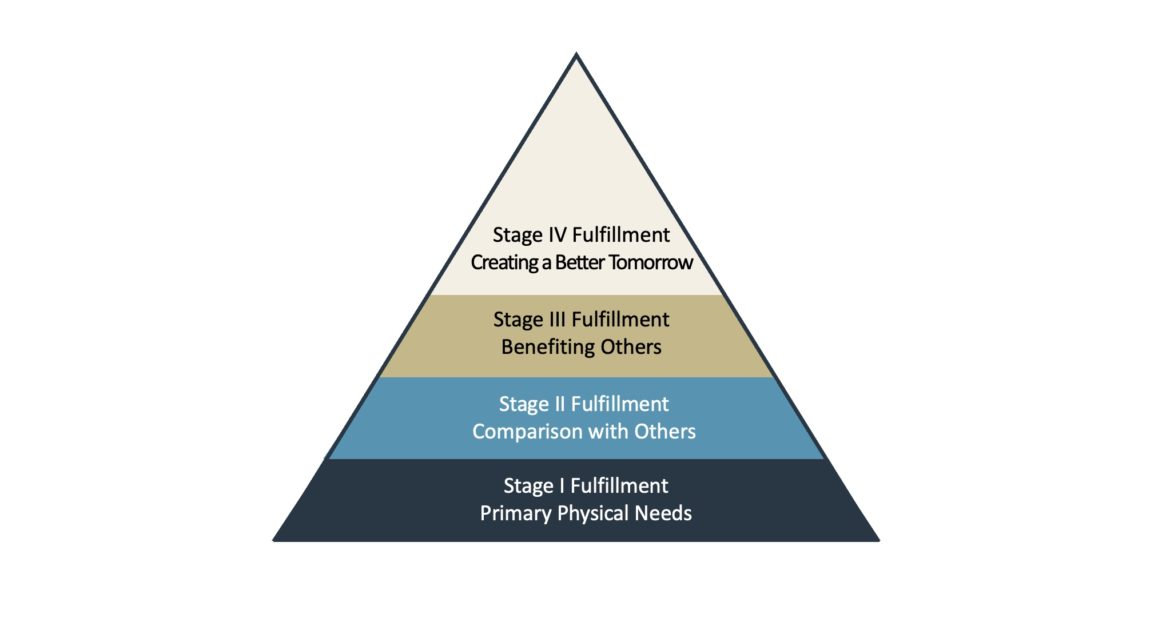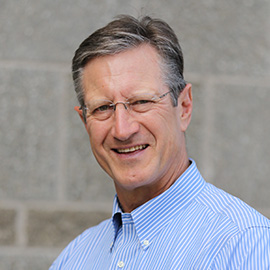The Four Why’s Behind What We Do

Here is another excerpt from The Shift from Me to Team, which will be published this year: it describes the Four Stages of Fulfillment we experience in life.
MY REQUEST OF YOU: We would appreciate your feedback. Please share what you like and what could be improved. #leadership #foundationofgreatness #team #teamdevelopment #purpose #vision #ShiftFromMeToTeam
Each of us is energized by various needs and desires, both short-term and long-term.
Over time, if we are doing the right things for the long term, we feel greater safety and security. We then feel the effects of what some call the “happiness hormones,” oxytocin and serotonin.
Influenced by Fr. Robert Spitzer’s “Four Levels of Happiness” and a behavioral assessment by my mentor, Don McMillan, we created the Four Stages of Fulfillment. Its simplicity resonates with clients, and we hope it resonates with you. The Four Stages of Fulfillment is a framework for understanding the motivation behind what we do each day, the why behind what we are doing now. The challenge: Is it strategic, is it purposeful in service of enabling something much deeper and more meaningful?
We present the Four Stages of Fulfillment to clients as an invitation to step away from the stress cycle of doing, and rather to think about our motivations and their impact on our energy, our lives, our health. This may be the most difficult part of your journey with us. To stop, think, and ask, “Why am I doing what I am doing, and how does it connect to what is most meaningful for me to make possible?
Stage I Fulfillment: Meeting Our Primary Physical Needs
We are born into the world seeking Stage I Fulfillment. When a baby is cold, wet, tired, or hungry, it cries. A baby is happy for a few hours at best, then the cycle begins again.
Stage I Fulfillment, and the satisfaction it creates, is short-term, but we must meet our primary needs or perish. Eating, sleeping, seeking comfort, warmth, safety—the better we take care of ourselves physically, the better chance we have of not just surviving, but thriving. Thus, Stage I Fulfillment can be viewed as the base of the pyramid—it better prepares us for our upward journey to experience the other three Stages of Fulfillment. The better we care for our physical and emotional well-being, the stronger the foundation we have to serve the higher stages of fulfillment.
Stage I Fulfillment Attributes
- Primary impact: self
- Understanding begins: at birth
- Looks like: eating for hunger, drinking for thirst, sleeping for rest, and dressing and setting the thermostat for comfort
- Fulfillment begins: immediately
- Fulfillment lasts: hours
- Significance: vital for individual survival
- Exemplars: infants, and those who need immediate physical gratification. You may know people whose Stage I Fulfillment needs are like gravity, always pulling them down from the higher levels of fulfillment.
Stage I Fulfillment is about their immediate needs with or without consideration of how it is impacting their ability to compete at the next stage of fulfillment.
Stage II Fulfillment: Comparison with Others
Each stage builds on the previous stage. When our primary needs have been met, and we mature, we seek Stage II Fulfillment, to compete and compare ourselves to others. We begin to understand Stage II in early adolescence. We desire a foundation for independence, and we learn and grow to pave our own path to survive and flourish.
Stage II Attributes
- Primary impact: ourselves compared to others
- Understanding begins: at youth
- Looks like: learning, growing, getting better, being competent; short-term accomplishment; can be showy if ego centered seeking prestige
- Fulfillment begins: immediately
- Fulfillment lasts: short-term; months
- Significance: builds competencies and confidence; provides a strong base of skills and knowledge
- Exemplars: gifted athletes, musicians, scientists, lottery winners, game show winners
Those who stop maturing and seek to win at this stage show their success and want all to know how accomplished they are. Those who continue to mature use the competencies built at Stage II to benefit others at Stage III.
Stage III Fulfillment: Benefiting Others
Stage III Fulfillment is sought by mature individuals who feel a strong sense of responsibility for the welfare of others.
In Stage III Fulfillment, satisfaction comes from supporting and enabling others to accomplish and succeed. Efforts as a helper, coach, or mentor may not yield fruit right away—it can take years or decades for the benefits of your efforts to be realized.
Having a Purpose that contributes to the benefit of others is critical in creating the energy needed for sustainable success, as a team, in business, and in life. Stage III Fulfillment utilizes the competencies built in Stage II but uses them in service of others.
Stage III Fulfillment Attributes
- Primary Impact: on others
- Understanding begins: most often in adulthood ages twenty-five to thirty-five; women get it before men
- Looks like: being energized to serve and to care for others
- Fulfillment begins: years later, when the fruits of our labors surface in others
- Fulfillment lasts: years, decades
- Significance: deeply impactful on society.
Our sustainable Purpose in life resides in Stage III Fulfillment. You can look to those who have meant the most to you, those you admire and respect in your life to see their Stage III Fulfillment in action.
Stage IV Fulfillment: Creating a Better Tomorrow
Whereas Stage III Fulfillment is rooted in the present, Stage IV Fulfillment is about living life with a vision that our actions in service of others today will create a better tomorrow. Stage IV is about working toward a better future we may never see; it is our Vision for tomorrow.
Stage IV Fulfillment Attributes
- Impact: future generations
- Understanding begins: late adulthood, around age fifty or so
- Looks like: faith that one’s actions will positively impact the future
- Fulfillment begins: ever-present; it is a feeling of contentment in living life with a deeply meaningful purpose
- Fulfillment lasts: ever present; always with us
- Significance: has a lasting positive impact on future generations. This is where a sustainable Visions for our life and organization reside
- Exemplars: researchers who toil for decades in hopes of a breakthrough, religious leaders, and medical professionals who will not see the results of their work; the rare politician who is thinking about a better future
Story of the Stages of Fulfillment
Seventeenth-century English architect Christopher Wren spoke with the men building St. Paul’s Cathedral in London, which he had designed. “What are you doing?” he asked. One man replied, “I am cutting a piece of stone.” Another said, “I am earning five shillings two-pence a day.” The third said, “I am helping Sir Christopher Wren build a beautiful cathedral.” The first two were living and thinking at Stage II Fulfillment. The third had Vision at Stage IV Fulfillment, which is much more motivating and inspiring, enabling Peak Performance to occur naturally.
Everything We Do Should Be in Service of Our Vision
Human nature is wired to be busy. Being busy is natural and easy but being productive and purposeful takes conscious effort until it becomes a habit. There is personal immediate gratification from being busy, so why slow down?
The visioning part of the Culture Clarification retreat connects what we are doing to what we are making possible—we are creating a Vision of what can be. An inspiring Vision captures our imagination and energizes us. What we do may not be motivating, but why we do it can be.






